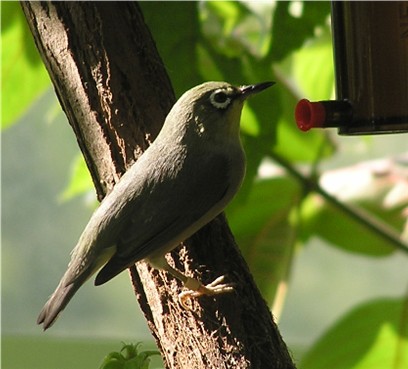 The tiny Indian white eye has long been a favorite cage bird both here and abroad. Captive bred individuals are readily available…for those of you considering something a bit different for your collection, this charming, warbler-like little fellow is worth a look.
The tiny Indian white eye has long been a favorite cage bird both here and abroad. Captive bred individuals are readily available…for those of you considering something a bit different for your collection, this charming, warbler-like little fellow is worth a look.
Physical Description
White-eyes are a mere 4-6 inches long, and clad in olive to bright green feathers about the head and back. The breast is bright yellow, and lighter yellow flecks color the rest of the plumage. The striking white eye-ring gives the species its common name and imparts a bright, alert “look”.
Range and Habitat
This and related species, a number of which have been interbred in the pet trade, ranges from India to China and south through Indonesia. Feral populations are established in many areas outside of the species’ natural distribution, including Hawaii.
Although usually described as inhabiting lowland forests, white eyes are actually quite adaptable and may colonize open scrubland, farms, villages and parks.
Miscellaneous
According to a recent (Jan. 2009) study funded by the American Museum of Natural History and other institutions, white eyes diversify into new species at a far faster rate than any other type of bird. Oddly, even populations that are separated by short distances (which could be easily crossed by the birds) regularly form new species.
Because the environments occupied by the different species are similar, speciation seems driven by something other than the need to adjust to a new food or climate (as is the case for other animals). It’s probably fortunate that Darwin considered Galapagos Island finches and not Solomon Island white eyes when formulating his thoughts on evolution…he might have become very confused!
Indian White Eyes as Pets
General
Despite their diminutive size, white eyes are invariably among the most visible birds in any aviary. This is due in part to their naturally confiding nature…they tame down very quickly and seem unusually confident around people. Even in a 2 acre aviary, those I kept were always very much in evidence. Quick to investigate the possibility of a meal, they always flew right to me when I first appeared each morning.
White eyes are quite active and alert, always hunting, preening and moving about, and are very inquisitive. Males sing quietly in sweet tones.
Space and Other Physical Requirements
White eyes require a larger enclosure than their small size would indicate. Provide them with a large indoor finch cage or, in warm weather, a planted outdoor aviary.
Light
Indoors, your pet’s cage should be lit by a full spectrum bird bulb.
Feeding
It does take a bit of effort to feed white eyes properly…most, myself included, find it well worthwhile, but please consider this point carefully before deciding to purchase a pair (they do best in pairs or small groups).
The natural diet consists largely of fruit and insects; captives will not thrive unless provided with a wide variety of each. Fruit can form a large portion of your pets’ diet…white eyes are especially fond of pears, and will accept oranges, grapes, papaya, banana, apples, mango and most other fruits as well. They must also be given a variety of small insects daily. Most aviculturists keeping white eyes establish fruit fly colonies…this is not difficult, and colonies are commercially available. Please write in if you’d like further information.
I would say that an insect trap is essential for the prospective white-eye owner. I highly recommend the Zoo Med Bug Napper. White eyes also relish small live crickets, mealworms and waxworms…but these alone do not constitute a sufficient diet. An ideal way of increasing dietary variety is to use finely chopped canned insects. I also suggest that you experiment with Zoo Med’s Anole Food. It contains tiny dried flies…when reconstituted with a bit of water it should prove acceptable to white eyes and similar birds.
Egg Food should be offered daily, in conjunction with a commercial insectivorous bird diet or a mix of cooked ground beef and hard boiled eggs (grind with shells). Goldenfeast Tropic Fruit Pudding Blend is a very interesting product that should prove useful to those rearing white eyes and birds with similar food preferences.
Several older bird-keepers of my acquaintance swore by pound cake soaked in honey water, using it as a bi-weekly treat for white-eyes, orioles, shama thrushes, bulbuls and many other birds. White eyes under my care consumed it ravenously.
Breeding
White eyes pair up readily and are fairly reliable breeders. They will utilize an open finch nest and cotton nesting material (spider webs are often incorporated into outdoor nests).
In nature, and in planted aviaries, white eyes tend to nest within dense vegetation. If you keep yours caged, it would be a good idea to situate their nest site behind a screen of live or artificial plants.
White eye hens lay 2-4 eggs, which are incubated by both parents for 10-12 days. The young fledge in a mere 12 days. Fruit flies and other tiny insects must be available to birds rearing chicks.
Additional Resources
A newly-discovered species breaks a few basic “white eye rules” (including the one about having a white eye ring!). Read more at:
http://www.sciencedaily.com/releases/2008/03/080314095059.htm
Image referenced from Wikipedia and originally posted by Factumquintus
 That Bird Blog – Bird Care and History for Pet Birds
That Bird Blog – Bird Care and History for Pet Birds


